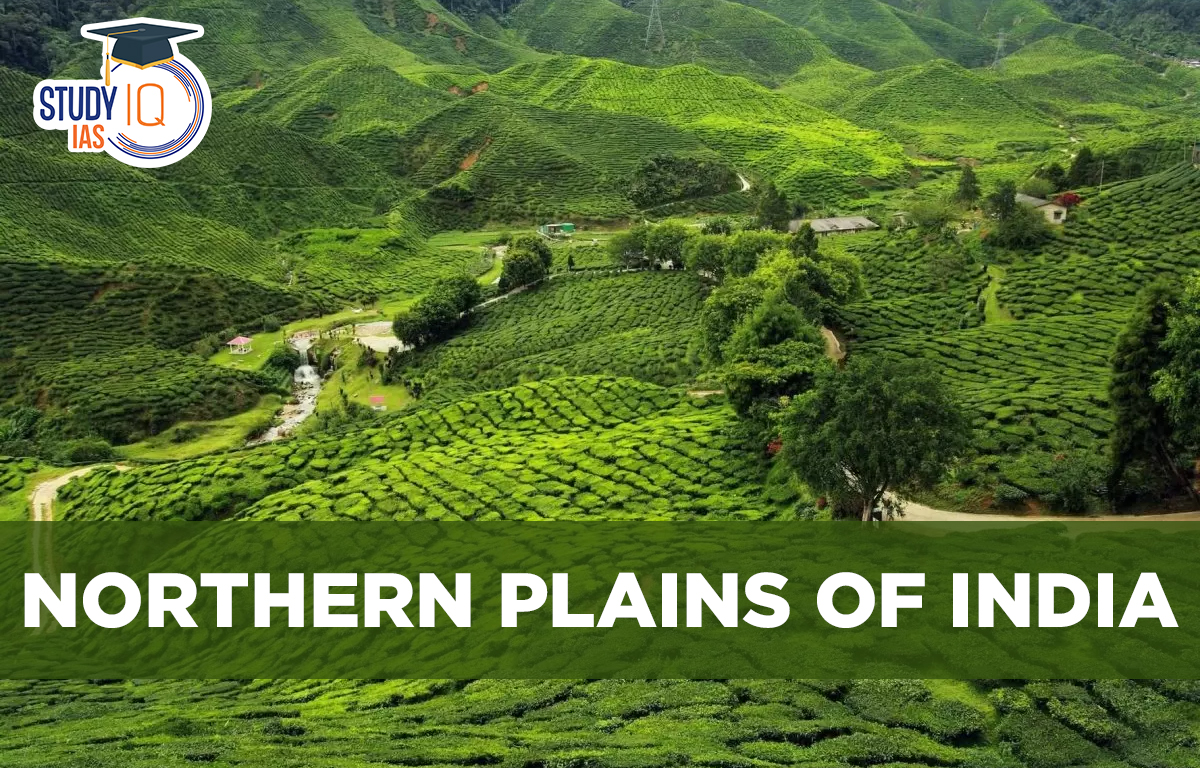Table of Contents
Northern Plains of India
The Northern Plains are the second-youngest region in India, after the Indian desert. They are bordered by the Shiwalik range in the north, the Desert in the west, the Peninsular Plateau in the south, and the Puruvachal Hills in the east.
The Northern Plains of India are created by the alluvial deposits of the Indus, Ganga, and Brahmaputra river systems and their tributaries. Stretches of the Northern Plains from west to east are around 2400 km long, and those from north to south are about 150–320 km long. The Northern Plains of India span an area of over 7 lakh square kilometers. Because of the abundant water supply, agreeable climate, and fertile alluvial soil, there is a large population. The rivers have a gentle slope, causing the water to flow slowly. Ambala in Haryana is the highest point at 291 meters above sea level, dividing the Ganga and Indus river systems.
| Northen Plains |
|
Ganga Plains
The Ganga plains stretch from the Yamuna catchment in the west to the Bangladesh border in the east. Between the Rajmahal hills and the Meghalaya plateau, part of Peninsular India sank, forming the lower Ganga plain, which was filled with sediments by the Ganga and Brahmaputra rivers.
The important features of these plains include levees, abandoned river courses, and the Bhabar, Tarai, Bhangar, and Khadar plains. Most rivers in this region change their paths, causing frequent floods. The Kosi River is especially known for this and is called the “Sorrow of Bihar.”
The Ganga plains cover the northern states of Haryana, Delhi, Uttar Pradesh, Bihar, part of Jharkhand, and West Bengal.
The Ganga-Brahmaputra delta is the largest delta in the world. The Sunderbans, a large mangrove forest, is part of this delta. The Sundari tree, which grows in marshes, gives the Sunderbans its name. Crocodiles and the Royal Bengal Tiger live there.
Rohilkhand Plain
The Rohilkhand Plain is located in the northwestern part of Uttar Pradesh and extends into parts of Uttarakhand. This flat, alluvial plain was formed by the deposition of silt and sediment from rivers like the Ganges and its tributaries. The region is primarily agricultural, with common crops including wheat, sugarcane, and rice. It experiences a subtropical climate, hot summers, moderate winters, and a monsoon season with heavy rainfall. Historically, the area has a rich past and was ruled by various local powers, including the Rohillas in the 18th century, from whom it gets its name. Major cities in the Rohilkhand Plain include Bareilly, Moradabad, and Rampur.
Awadh Plain
The Awadh Plain is located in the northern part of Uttar Pradesh and extends into parts of Bihar. This flat, fertile alluvial plain was formed by silt deposits from the Ganges River and its tributaries. The region is heavily agricultural, producing crops like wheat, sugarcane, rice, and pulses.
The Awadh Plain has a subtropical climate with hot summers, moderate winters, and heavy monsoon rains. It was once part of the kingdom of Awadh, an important cultural and political region. Major cities include Lucknow, Kanpur, and Faizabad. The plain is known for its flatlands, fertile soil, and a network of rivers and canals that support farming.
Rarh Plain
The Rarh region is located between the Chota Nagpur Plateau in the west and the main flow of the Ganges River in the east. The lower Gangetic plains to the west of the Bhagirathi-Hooghly and south of the Ganges River are called the Rarh lowlands. These plains were formed by old alluvial deposits. The main river is the Damodar, and the elevation ranges from 75 to 150 meters. The area is heavily industrialized and was once known for its severe floods
Chhattisgarh Plain
It has a saucer-like shape and is drained by the upper Mahanadi River. The plain lies between the Maikala Range and the Odisha hills. It is bordered by the Chota Nagpur Plateau to the north, the Raipur Upland to the east, the Bastar Plateau to the southeast, and the Maikala Range to the west.
The area was once ruled by the Haithaivanshi Rajputs who built 36 forts, giving the region its name Chhattisgarh. The basin has layers of shales and limestone. Known as India’s “rice bowl,” the plain has developed due to its rich coal reserves and large amounts of iron ore, bauxite, manganese, and commercial clays.
The elevation of the plain ranges from 250 meters in the east to 330 meters in the west. Major commercial centers include Bhilai, Bilaspur, Raipur, Raigarh, and Durg. Other growing urban areas are Rajgarh, Korba, and Nandgaon.
Northern Plains of India Physiographic Divisions
Bhabar Plains
- At the break in the slope, a thin band called Bhabar extends between 8 and 10 km parallel to the Shiwalik foothills. Because of this, the streams and rivers that originate in the mountains often disappear in this area and leave behind heavy materials made of rocks and boulders.
- There are only giant trees with deep roots in the area, which makes it unsuitable for cultivation.
- There are building materials available in this region
Tarai Plains
- South of Bhabar, a marshy tract reappears; this area is known as Terai.
- In this region the streams reappear and make a wet, swampy and marshy region
- The lush natural vegetation here supports a wide range of fauna.
- These forests are cut down in the Indian state of Uttar Pradesh to make way for the cultivation of wheat, rice, and sugarcane.
Bhangar Plains
- Bhangar is the largest part of the northern plain and is composed of the oldest alluvial soil
- The calcium-rich, dark-colored alluvium is known as kankar.
- Clay makes up the majority of Bhangar’s soil, but loam and sandy-loam can occasionally be found there as well.
- The presence of saline and alkaline efflorescence’s known as Reh in dry places.
Khadar Plains
- The flood plains formed by new alluvial are called Khadar
- The soil in this region is renewed every year and is highly fertile
- This region is very suitable for intensive agricultural activities
Delta Plains
Delta plains form where rivers meet larger bodies of water like seas or oceans. As the river slows down, it loses its sediment load and spreads out, creating a delta shape. These plains are located where rivers diverge and fan out into larger water bodies, extending into the sea or a lake. Delta plains are characterized by their distinctive shapes (e.g., arcuate, cuspate, bird’s foot) and are formed by the accumulation of sediments carried by the river and deposited as it slows down and spreads out.
Northern Plains of India Regional Division
Rajasthan Plains
- To the west of Aravalis, this contains the Marusthali and Rajasthan Bagar regions.
- Several brackish lakes are present in this area as a result of the marine submergence that once existed. Sambhar is one such lake.
- Though several inland drainage systems exist, only Luni reaches the ocean.
- Sweet in the upper areas, Luni becomes salty in the lower regions.
- The area is covered in dunes and sand.
- It is 25 cm Isohyet away from the Bagar district.
- Bagar is a fertile, semi-arid region that is drained by the Luni river in the south.
Punjab Haryana plain
- The Punjab Plains form the western part of the Northern plains.
- These are the result of river deposits from the Satluj Beas and Ravi rivers.
- The Doabs, are found in the Punjab plains, which is a region or land lying between and reaching the meeting of the two rivers.
- Due to little streams called Chos, the northern half of the region has seen significant erosion.
Northern Plains of India Formation
The Northern Plains of India were formed over millions of years through geological and hydrological processes. Located between the Himalayas in the north and the Peninsular Plateau in the south, these plains were created by sediments from the Ganges, Yamuna, Brahmaputra, and their tributaries. Rivers carried silt, sand, and clay from the Himalayas, depositing them on the plains. The rising Himalayas caused rivers to erode more land, increasing sediment transport. As a result, the plains have multiple layers of alluvial deposits from different times. Rivers often change course and flood, adding more sediments and reshaping the land. Today, the Northern Plains are known for their fertile soil, extensive farming, and dense population due to rich alluvial deposits and a favorable climate.
States in Northern Plains of India
| Northen Plains of India States |
|
These are the states that make up the Northern Plains in India.
Northern Plains of India Rivers
| Rivers that formed the Northern Plains |
|
These are the major rivers of Northern Plains of India
Crops Grown in Northern Plains of India
Due to the fertile soil in this area, the Northern Plains are best suited for agriculture. Some of the crops planted here are
| Crops in Northern Plains |
|
Northern Plains of India Significance
Fertile soil, many rivers, and a good climate make the best places for people to live. Many dams are built for different purposes, like providing water for farming and generating electricity. There are many important works of literature, art, and architecture, and sacred rivers have social and religious importance. The rivers in the plains are easy to navigate, which helps with trade and transportation.
Northern Plains of India Features
- The Indus, Ganga, and Brahmaputra river systems’ alluvial deposits, as well as those of their tributaries, are what created the northern plains.
- The soil on this plain is entirely alluvial.
- The plains are ideal for agriculture since they are quite fertile.
- Due to their fertile fields and agriculture-based economy, these plains are heavily populated.
Other Indian Geography Topics
Other Fundamental Geography Topics


 Indus Valley Civilization, History, Phas...
Indus Valley Civilization, History, Phas...
 Summer Solstice, Definition, Reason and ...
Summer Solstice, Definition, Reason and ...
 Bihar Caste Census Report 2023, Caste Wi...
Bihar Caste Census Report 2023, Caste Wi...





















